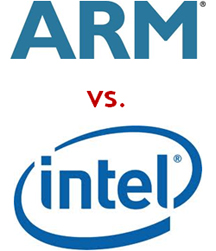Intel Puts ARM on Notice
By Tony Clark, 2-Dooz Inc. – December 24, 2012 (Original Publication Date)

 A couple of months ago, I speculated on what I believe is Intel’s mobile computing strategy, especially with respect to their battle with ARM for the hardware hearts and souls of smart phones and tablet computers. I’m officially on record having said that I fully expect Intel to leverage its design and manufacturing leadership to successfully counter ARM by targeting and implementing major energy conservation and performance improvements in its processors. Last week Intel announced important developments regarding this strategy.
A couple of months ago, I speculated on what I believe is Intel’s mobile computing strategy, especially with respect to their battle with ARM for the hardware hearts and souls of smart phones and tablet computers. I’m officially on record having said that I fully expect Intel to leverage its design and manufacturing leadership to successfully counter ARM by targeting and implementing major energy conservation and performance improvements in its processors. Last week Intel announced important developments regarding this strategy.
A little background and context is helpful first.
Transistors are the building blocks for all modern electronic equipment: computers, smart phones, consumer electronics, etc. In May of this year, Intel announced a new revolutionary 3-D transistor design called “Tri-Gate.” Tri-Gate is the first transistor to leverage three dimensions. All prior transistors over the past 50 years have used two dimensional designs. A large advantage of 3-D over 2-D is the ability to scale the transistor into smaller and smaller footprints. Note that the Tri-Gate transistors are initially targeted to Intel’s industry leading 22nm manufacturing processes.
Benefits of the Tri-Gate design include the following: increased current flow when the transistor is in the "on" state; close to zero current flow when the transistor is in the "off" state, which minimizes power losses due to leakage (and, in turn, enables longer battery life in standby mode for example); and faster switching between the on and off states, which improves performance, e.g., speed, responsiveness, etc.
The second of the aforementioned benefits is especially important for smart phones and tablet computers. Tri-Gate transistors enable chips to operate at lower voltage with lower leakage, relative to two dimensional transistor based designs. According to Intel, “The new transistors consume less than half the power when at the same performance as 2-D planar transistors on 32nm chips.” Thus, Tri-Gate transistors along with Intel’s manufacturing process leadership are key pillars in the company’s strategy to fend off ARM.
Last week in an interview, Mark Bohr, Intel Senior Fellow, publically confirmed for the first time that Intel had successfully cleared all manufacturing hurdles for the Tri-Gate technology, including the achievement of extremely low defect rates, which is needed for high volume production. The announcement provided definitive proof that Intel can and is executing its smart phone and tablet computer strategy. Namely, Intel is targeting and implementing major energy conservation and performance improvements in its processors and system on chip designs—delivering lower power consuming chips without compromising performance. Consequently, designers can now be confident of the availability of ARM alternatives. And, with the announcement last week, ARM has officially been given notice that its battle with Intel has only just begun.
Those are my thoughts. As always, I invite and look forward to learning what you think.
